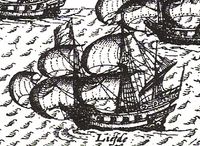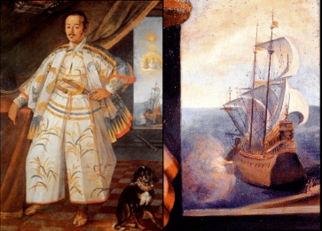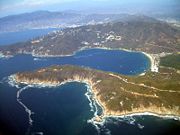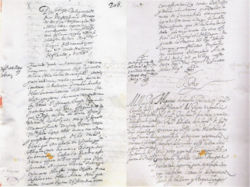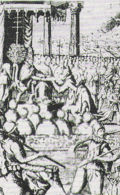Hasekura Tsunenaga
2008/9 Schools Wikipedia Selection. Related subjects: Historical figures
- In this Japanese name, the family name is Hasekura.
| Hasekura Rokuemon Tsunenaga (1571–1622)  Hasekura's portrait during his mission in Rome in 1615, by Claude Deruet, Coll. Borghese, Rome |
||
| Names: | ||
|---|---|---|
| Japanese name: | Hasekura Rokuemon Tsunenaga (支倉六右衛門常長) |
|
| Christian name: | Don Felipe Francisco Hasekura | |
| Retainer of: | ||
| Overlord: | Date Masamune | |
| Fief: | Sendai Domain (仙台藩) (Northeastern Japan) |
|
Hasekura Rokuemon Tsunenaga (1571 – 1622) ( Japanese: 支倉六右衛門常長, also spelled Faxecura Rocuyemon in period European sources, reflecting the contemporary pronunciation of Japanese) was a Japanese samurai and retainer of Date Masamune, the daimyo of Sendai.
In the years 1613 through 1620, Hasekura headed a diplomatic mission to the Vatican in Rome, traveling through New Spain (arriving in Acapulco and departing from Veracruz) and visiting various ports-of-call in Europe. This historic mission is called the Keichō Embassy, 慶長使節). On the return trip, Hasekura and his companions re-traced their route across Mexico in 1619, sailing from Acapulco for Manilla, and then sailing north to Japan in 1620. This is conventionally considered the first Japanese ambassador in the Americas and in Europe.
Although Hasekura's embassy was cordially received in Europe, it happened at a time when Japan was moving toward the suppression of Christianity. European monarchs such as the King of Spain thus refused the trade agreements Hasekura had been seeking. Hasekura returned to Japan in 1620 and died of illness a year later, his embassy seemingly ending with few results in an increasingly isolationist Japan.
Japan's next embassy to Europe would only occur more than 200 years later, following two centuries of isolation, with the " First Japanese Embassy to Europe" in 1862.
Early life
Little is known of the early life of Hasekura Tsunenaga. He was a mid-level noble samurai in the Sendai Domain in northern Japan, who had the opportunity to directly serve the daimyo Date Masamune. They were of roughly the same age, and it is recorded that several important missions were given to Tsunenaga as his representative.

It is also recorded that Hasekura served as samurai of the Japanese invasion of Korea under the Taiko Toyotomi Hideyoshi, during six months in 1597.
In 1612, Hasekura's father, Hasekura Tsunenari (支倉常成), was indicted for corruption, and he was put to death in 1613. His fief was confiscated, and his son should normally have been executed as well. Date however gave him the opportunity to redeem his honour by placing him in charge of the Embassy to Europe, and soon gave him back his territories as well.
Background: early contacts between Japan and Spain
The Spanish started trans-Pacific voyages between New Spain (Mexico) and the Philippines in 1565. The famous Manila galleons carried silver from Mexican mines westward to the entrepôt of Manila in the Spanish possession of the Philippines. There, the silver was used to purchase spices and trade goods gathered from throughout Asia, including (until 1638) goods from Japan. The return route of the Manila galleons, first charted by the Basque navigator Andrés de Urdaneta, took the ships northeast into the Kuroshio Current (also known as the Japan Current) off the coast of Japan, and then across the Pacific to the west coast of North America, landing eventually in Acapulco.
Spanish ships were periodically shipwrecked on the coasts of Japan due to bad weather, initiating contacts with the country. The Spanish wished to expand the Christian faith in Japan. Efforts to expand influence in Japan were met by stiff resistance from the Jesuits, who had started the evangelizing of the country in 1549, as well as the Portuguese and the Dutch who did not wish to see Spain participate in Japanese trade. However, some Japanese, such as Christopher and Cosmas, are known to have crossed the Pacific onboard Spanish galleons as early as 1587. It is known that gifts were exchanged between the governor of the Philippines and Toyotomi Hideyoshi, who thanks him in a 1597 letter, writing "The black elephant in particular I found most unusual."
In 1609, the Spanish Manila galleon San Francisco encountered bad weather on its way from Manila to Acapulco, and was wrecked on the Japanese coast in Chiba, near Tokyo. The sailors were rescued and welcomed, and the ship's captain, Rodrigo de Vivero, former interim governor of the Philippines, met with the retired shogun Tokugawa Ieyasu. Rodrigo de Vivero drafted a treaty, signed on 29 November 1609, whereby the Spaniards could establish a factory in eastern Japan, mining specialists would be imported from New Spain, Spanish ships would be allowed to visit Japan in case of necessity, and a Japanese embassy would be sent to the Spanish court.
First Japanese expeditions to the Americas
1610 San Buena Ventura
A Franciscan monk named Luis Sotelo, who was proselytizing in the area of Tokyo, convinced Tokugawa Ieyasu and his son Tokugawa Hidetada to send him as a representative to New Spain (Mexico) on one of their ships, in order to advance the trade treaty. Rodrigo de Vivero offered to sail on the Japanese ship in order to guarantee the safety of their reception in New Spain, but insisted that another Franciscan, named Alonso Muños, be sent instead as the Shogun's representative. In 1610, the returning Rodrigo de Vivero, several Spanish sailors, the Franciscan father, and 22 Japanese representatives led by the trader Tanaka Shosuke, sailed to Mexico aboard the San Buena Ventura, a ship built by the English adventurer William Adams for the Shogun. Once in New Spain, Alonso Muños met with the Viceroy Luis de Velasco, who agreed to send an ambassador to Japan in the person of the famous explorer Sebastian Vizcaino, with the added mission of exploring the "Gold and silver islands" ("Isla de Plata") that were thought to be east of the Japanese isles.
Vizcaino arrived in Japan in 1611, and had many meetings with the Shogun and feudal lords. These encounters were tainted by his poor respect for Japanese customs, the mounting resistance of the Japanese towards Catholic proselytism, and the intrigues of the Dutch against Spanish ambitions. Vizcaino finally left to search for the "Silver island", during which search he encountered bad weather, forcing him to return to Japan with heavy damage.
1612 San Sebastian
Without waiting for Vizcaino, another ship – built in Izu by the Bakufu under the minister of the Navy Mukai Shogen, and named San Sebastian – left for Mexico on 9 September 1612 with Luis Sotelo onboard as well as two representatives of Date Masamune, with the objective of advancing the trade agreement with New Spain. However, the ship foundered a few miles from Uraga, and the expedition had to be abandoned.
The 1613 embassy project

The Shogun decided to build a new galleon in Japan in order to bring Vizcaino back to Nueva España, together with a Japanese embassy accompanied by Luis Sotelo. The galleon, named Date Maru by the Japanese and later San Juan Bautista by the Spanish, took 45 days work in building, with the participation of technical experts from the Bakufu (the Minister of the Navy Mukai Shogen, an acquaintance of William Adams with whom he built several ships, dispatched his Chief Carpenter), 800 shipwrights, 700 smiths, and 3,000 carpenters. The daimyo of Sendai, Date Masamune, was put in charge of the project. He named one of his retainers, Hasekura Tsunenaga (his fief was rated at around 600 koku), to lead the mission:
- "The Great Ship left Toshima-Tsukinoura for the Southern Barbarians on September 15th [Japanese calendar], with at its head Hasekura Rokuemon Tsunenaga, and those called Imaizumi Sakan, Matsuki Shusaku, Nishi Kyusuke, Tanaka Taroemon, Naito Hanjuro, Sonohoka Kyuemon, Kuranojo, Tonomo, Kitsunai, Kyuji, as well as several others under Rokuemon, as well as 40 Southern Barbarians, 10 men of Mukai Shogen, and also tradespeople, to a total 180" (Records of the Date House, Keichō-Genna 伊達家慶長元和留控, Gonoi p. 56).
The objective of the Japanese embassy was both to discuss trade agreements with the Spanish crown in Madrid, and to meet with the Pope in Rome. Date Masamune displayed a great will to welcome the Catholic religion in his domain: he invited Luis Sotelo and authorized the propagation of Christianity in 1611. In his letter to the Pope, brought by Hasekura, he wrote: "I'll offer my land for a base of your missionary work. Send us as many padres as possible."
Sotelo, in his own account of the travels, emphasizes the religious dimension of the mission, claiming that the main objective was to spread the Christian faith in northern Japan:
- "I was formerly dispatched as ambassador of Idate Masamune, who holds the reins of the kingdom of Oxu [Japanese:奥州] (which is in the Eastern part of Japan) —who, while he has not yet been reborn through baptism, has been catechized, and was desirous that the Christian faith should be preached in his kingdom—together with another noble of his Court, Philippus Franciscus Faxecura Rocuyemon, to the Roman Senate & to the one who at that time was in charge of the Apostolic See, His Holiness Pope Paul V." (Luis Sotelo De Ecclesiae Iaponicae Statu Relatio, 1634).
The embassy was probably, at that time, part of a plan to diversify and increase trade with foreign countries, before the participation of Christians in the Osaka rebellion triggered a radical reaction from the Shogunate, with the interdiction of Christianity in the territories it directly controlled, in 1614.
Trans-Pacific voyage
Upon completion, the ship left on 28 October 1613 for Acapulco with around 180 people on board, including 10 samurai of the Shogun (provided by the Minister of the Navy Mukai Shogen Tadakatsu), 12 samurai from Sendai, 120 Japanese merchants, sailors, and servants, and around 40 Spaniards and Portuguese, including Sebastian Vizcaino who, in his own words, only had the quality of a passenger.
New Spain (Acapulco)

A. The ships of the expedition.
B. The castle of San Diego.
C. The town.
D. A ship that has come from Japan.
E. Los Manzanillos.
F. El Grifo.
The ship first reached Cape Mendocino in today's California, and then continued along the coast to arrive in Acapulco on 25 January 1614 after three months at sea. The Japanese were received with great ceremony, but had to wait in Acapulco until orders were received regarding how to organize the rest of their travels.
Fights erupted between the Japanese and the Spaniards, especially Vizcaino, apparently due to some disputes on the handling of presents from the Japanese ruler. A contemporary journal, written by the historian Chimalpahin Quauhtlehuanitzin, a noble Aztec born in Amecameca (ancient Chalco province) in 1579, whose formal name was Domingo Francisco de San Anton Muñon, relates Vizcaino was seriously wounded in the fight:
- "Senor Vizcaino is still coming slowly, coming hurt; the Japanese injured him when they beat and stabbed him in Acapulco, as became known here in Mexico, because of all the things coming along that had been made his responsibility in Japan"
Following these fights, orders were promulgated on March 4th and March 5th to bring peace back. The orders explained that:
- "The Japanese should not be submitted to attacks in this Land, but they should remit their weapons until their departure, except for Hasekura Tsunenaga and eight of his retinue... The Japanese will be free to go where they want, and should be treated properly. They should not be abused in words or actions. They will be free to sell their goods. These orders have been promulgated to the Spanish, the Indians, the Mulattos, the Mestizos, and the Blacks, and those who don't respect them will be punished".
New Spain (Mexico)
The embassy remained two months in Acapulco and entered Mexico City on 24 March, where it was received with great ceremony. The ultimate mission for the embassy was to go on to Europe. The embassy spent some time in Mexico, and then went to Veracruz to board the fleet of Don Antonio Oquendo.
Chimalpahin gives some account of the visit of Hasekura.
- "This is the second time that the Japanese have landed one of their ships on the shore at Acapulco. They are transporting here all things of iron, and writing desks, and some cloth that they are to sell here." (Chimalpahin, "Annals of His Time").
- "It became known here in Mexico and was said that the reason their ruler the Emperor of Japan sent this said lordly emissary and ambassador here, is to go in Rome to see the Holy Father Paul V, and to give him their obedience concerning the holy church, so that all the Japanase want to become Christians" (Chimalpahin, "Annals of His Time").
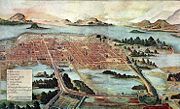
Hasekura was setted in a house next to the Church of San Francisco, and met with the Viceroy. He explained to him that he was also planning to meet King Philip III to offer him peace and to obtain that the Japanese could come to Mexico for trade. On Wednesday 9 April, 20 Japanese were baptized, and 22 more on 20 April by the archbishop in Mexico, don Juan Pérez de la Serna, at the Church of San Francisco. Altogether 63 of them received confirmation on 25 April. Hasekura waited for his travel to Europe to be baptized there:
- "But the lordly emissary, the ambassador, did not want to be baptized here; it was said that he will be baptized later in Spain" (Chimalpahin, "Annals of His Time").
Departure for Europe
Chimalpahin explains that Hasekura left some of his compatriots behind before leaving for Europe:
- "The Ambassador of Japan set out and left for Spain. In going he divided his vassals; he took a certain number of Japanese, and he left an equal number here as merchants to trade and sell things." (Chimalpahin, "Annals of His Time").
The fleet left for Europe on the San Jose on 10 June. Hasekura had to leave the largest parts of the Japanese group behind, who were to wait in Acapulco for the return of the embassy.
Some of them, as well as those from the previous travel of Tanaka Shosuke, returned to Japan the same year, sailing back with the San Juan Bautista:
- "Today, Tuesday the 14th of the month of October of the year 1614, was when some Japanese set out from Mexico here going home to Japan.; they lived here in Mexico for four years. Some still remained here; they earn a living trading and selling here the goods they brought with them from Japan." (Chimalpahin, "Annals of His Time").
Cuba
The embassy stopped and changed ships in Havana in Cuba in July 1614. A bronze statue was erected on 26 April 2001 at the head of Havana Bay.
Mission to Europe
Spain
The fleet arrived in Sanlucar de Barrameda on 5 October 1614.
- "The fleet arrived safely finally, after some dangers and storms, to the port of Sanlúcar de Barrameda on the 5th of October, where the Duke of Medina Sidonia was advised of the arrival. He sent carriages to honour them and accommodate the Ambassador and his gentlemen" (Scipione Amati "History of the Kingdom of Voxu").
- "The Japanese ambassador Hasekura Rokuemon, sent by Joate Masamune, king of Boju, entered Seville on Wednesday, 23 October 1614. He was accompanied by 30 Japanese with blades, their captain of the guard, and 12 bowmen and halberdiers with painted lances and blades of ceremony. The captain of the guard was Christian and was called Don Thomas, the son of a Japanese martyr" (Library Capitular Calombina 84-7-19 Memorias..., fol.195).
The Japanese embassy met with King Philip III in Madrid on 30 January 1615. Hasekura remitted to the King a letter from Date Masamune, as well as offer for a treaty. The King responded that he would do what he could to accommodate these requests.
Hasekura was baptized on 17 February by the king's personal chaplain, and renamed Felipe Francisco Hasekura. The baptism ceremony was to have been conducted by the Archbishop of Toledo, though he was too ill to actually carry this out, and the Duke of Lerma – the main administrator of Phillip III's rule and the de facto ruler of Spain – was designated as Hasekura's godfather.
The embassy stayed eight months in Spain before leaving the country for Italy.
France
After traveling across Spain, the embassy sailed on the Mediterranean Sea aboard three Spanish frigates towards Italy. Due to bad weather, they had to stay for a few days in the French harbour of Saint-Tropez, where they were received by the local nobility, and made quite a sensation on the populace.
The visit of the Japanese Embassy is recorded in the city's chronicles as led by "Philip Francis Faxicura, Ambassador to the Pope, from Date Masamunni, King of Woxu in Japan".
Many picturesque details of their movements were recorded:
- "They never touch food with their fingers, but instead use two small sticks that they hold with three fingers."
- "They blow their noses in soft silky papers the size of a hand, which they never use twice, so that they throw them on the ground after usage, and they were delighted to see our people around them precipitate themselves to pick them up."
- "Their swords cut so well that they can cut a soft paper just by putting it on the edge and by blowing on it."
- ("Relations of Mme de St Troppez", October 1615, Bibliotheque Inguimbertine, Carpentras).
- "They blow their noses in soft silky papers the size of a hand, which they never use twice, so that they throw them on the ground after usage, and they were delighted to see our people around them precipitate themselves to pick them up."
The visit of Hasekura Tsunenaga to Saint-Tropez in 1615 is the first recorded instance of Franco-Japanese relations.
Italy


The Japanese Embassy went on to Italy where they were able to meet with Pope Paul V in Rome in November 1615, the same year Galileo Galilei was first confronted by the Roman Inquisition regarding his findings against geocentricism. Hasekura remitted to the Pope two gilded letters, one in Japanese and one in Latin, containing a request for a trade treaty between Japan and Mexico and the dispatch of Christian missionaries to Japan. These letters are still visible in the Vatican archives. The Latin letter, probably written by Luis Sotelo for Date Masamune, reads, in part:
- Kissing the Holy feet of the Great, Universal, Most Holy Lord of The Entire World, Pope Paul, in profound submission and reverence, I, Idate Masamune, King of Wôshû in the Empire of Japan, suppliantly say:
- The Franciscan Padre Luis Sotelo came to our country to spread the faith of God. On that occasion, I learnt about this faith and desired to become a Christian, but I still haven't accomplished this desire due to some small issues. However, in order to encourage my subjects to become Christians, I wish that you send missionaries of the Franciscan church. I guarantee that you will be able to build a church and that your missionaries will be protected. I also wish that you select and send a bishop as well. Because of that, I have sent one of my samurai, Hasekura Rokuemon, as my representative to accompany Luis Sotelo across the seas to Rome, to give you a stamp of obedience and to kiss your feet. Further, as our country and Nueva España are neighbouring countries, could you intervene so that we can discuss with the King of Spain, for the benefit of dispatching missionaries across the seas." Translation of the Latin letter of Date Masamune to the Pope.
The Pope agreed to the dispatch of missionaries, but left the decision for trade to the King of Spain.
The Roman Senate also gave to Hasekura the honorary title of Roman Citizen, in a document he brought back to Japan, and which is preserved today in Sendai.
Sotelo also described the visit to the Pope, book De ecclesiae Iaponicae statu relatio (published posthumously in 1634):
- "When we got there by the aid of God in the Year of Our Salvation 1615, not only were we kindly received by His Holiness the great Pope, with the Holy College of the Cardinals and a gathering of bishops and nobles, and even the joy and general happiness of the Roman People, but we and three others (whom the Japanese Christians had specially designated to announce their condition with respect to the Christian religion) were heard, rested, and just as we were hoping, dispatched as quickly as possible." (Sotelo, De ecclesiae Iaponicae statu relatio).
Rumours of political intrigue
Besides the official description of Hasekura's visit to Rome, some contemporary communications tend to indicate that political matters were also discussed, and that an alliance with Date Masamune was suggested as a way to establish Christian influence in the whole of Japan:
- "The Ambassador strongly insisted that the authority and power of his ruler was superior to that of many European countries" (Anonymous Roman communication, dated October 10, 1615)
- "The Franciscan Spanish fathers are explaining that the King of the Ambassador [Hasekura Tsunenaga] will soon become the supreme ruler of his country, and that, not only will they become Christians and follow the will of the church of Rome, but they will also in turn convert the rest of the population. This is why they are requesting the dispatch of a high eclesiastic together with the missionaries. Because of this, many people have been doubting the true purpose of the embassy, and are wondering if they are not looking for some other benefit." (Letter of the Venetian ambassador, November 7, 1615).
Second visit to Spain
For the second time in Spain, Hasekura met again with the King, who declined to sign a trade agreement, on the ground that the Japanese Embassy did not appear to be an official embassy from the ruler of Japan Tokugawa Ieyasu, who, on the contrary, had promulgated an edict in January 1614 ordering the expulsion of all missionaries from Japan, and started the persecution of the Christian faith in Japan.
The embassy left Seville for Mexico in June 1617 after a period of two years spent in Europe, but some of the Japanese remained in Spain in a town near Seville ( Coria del Río), where their descendants to this day still use the surname Japón.
Western publications on Hasekura's embassy
The embassy of Hasekura Tsunenaga was the object of numerous publications throughout Europe. The Italian writer Scipione Amati, who accompanied the embassy in 1615 and 1616, published in 1615 in Rome a book titled "History of the Kingdom of Voxu". This book was also translated in German in 1617. In 1616, the French publisher Abraham Savgrain published an account of Hasekura's visit to Rome: "Récit de l'entrée solemnelle et remarquable faite à Rome, par Dom Philippe Francois Faxicura" ("Account of the solemn and remarquable entrance in Rome of Dom Philippe Francois Faxicura").
Return to Mexico
Hasekura stayed for 5 months in Mexico on his way back to Japan. The San Juan Bautista was waiting in Acapulco since 1616, after a second trip across the Pacific from Japan to Mexico. Captained by Yokozawa Shogen, she was laden with fine pepper and lacquerware from Kyoto, which were sold on the Mexican market. Following a request by the Spanish king, in order to avoid too much silver leaving to Japan, the Viceroy asked for the proceeds to be spent on Mexican goods, except for an amount of 12,000 pesos and 8,000 pesos in silver which Hasekura and Yokozawa could bring back with them respectively.
Philippines
In April 1618, the San Juan Bautista arrived in the Philippines from Mexico, with Hasekura and Luis Sotelo on board. The ship was acquired by the Spanish government there, with the objective of building up defenses against the attacks of the Dutch and the English. The bishop of the Philippines with the local Filipinos and native Tagalog in Manila described the deal to the king of Spain in a missive dated 28 July 1619:
- "The Governor was extremely friendly with the Japanese, and provided them with his protection. As they had many expensive things to buy, they decided to lend their ship. The ship was immediately furbished for combat. The Governor eventually bought the ship, because it turned out that it was of excellent and sturdy construction, and available ships were dramatically few. In favour of your Majesty, the price paid was reasonable." (Document 243)
During his stay in the Philippines with the local Filipinos, Hasekura purchased numerous goods for Date Masamune, and built a ship, as he explained in a letter he wrote to his son. He finally returned to Japan in August 1620, reaching the harbour of Nagasaki.
Return to Japan
By the time Hasekura came back, Japan had changed quite drastically: an effort to eradicate Christianity had been under way since 1614, Tokugawa Ieyasu had died in 1616 and been replaced by his more xenophobic son Tokugawa Hidetada, and Japan was moving towards the " Sakoku" policy of isolation. Because news of these persecutions arrived in Europe during Hasekura's embassy, European rulers – especially the King of Spain – became very reluctant to respond favorably to Hasekura's trade and missionary proposals.

Hasekura reported his travels to Date Masamune upon his arrival in Sendai. It is recorded that he remitted a portrait of Pope Paul V, a portrait of himself in prayer (shown above), and a set of Ceylonese and Indonesian daggers acquired in the Philippines, all preserved today in the Sendai City Museum. The "Records of the House of Masamune" describe his report in a rather succinct manner, ending with a rather cryptic expression of surprise bordering on the outrage ("奇怪最多シ") at Hasekura's discourse:
- "Rokuemon went to the country of the Southern Barbarians, he paid his respects to the king Paolo, he stayed there for several years, and now he sailed back from Luzon. He brought paintings of the king of the Southern Barbarians, and a painting of himself, which he remitted. Many of his descriptions of the Southern Barbarian countries, and the meaning of Rokuemon's declarations were surprising and extraordinary."
Interdiction of Christianity in Sendai
The direct effect of Hasekura's return to Sendai was the interdiction of Christianity in the Sendai fief two days later:
- "Two days after the return of Rokuemon to Sendai, a three-point edict against the Christian was promulgated: first, that all Christians were ordered to abandon their faith, in accordance with the rule of the Shogun, and for those who did not, they would be exiled if they were nobles, and killed if they were citizens, peasants or servants. Second, that a reward would be given for the denunciation of hidden Christians. Third that propagators of the Christian faith should leave the Sendai fief, or else, abandon their religion" (November 1620 letter of father Angelis, Japan-China archives of the Jesuits in Rome, quoted in Gonoi's "Hasekura Tsunenaga", p231)
What Hasekura said or did to bring about such a result is unknown. As later events tend to indicate that he and his descendants remained faithful Christians, Hasekura may have made an enthusiastic – and to a certain extent, disturbing – account of the greatness and might of Western countries and the Christian religion. He may also have encouraged an alliance between the Church and Date Masamune to take over the country (an idea advertized by the Franciscans while in Rome), which, in 1620 Japan, would have been a totally unrealistic proposition. Lastly, hopes of trade with Spain evaporated when Hasekura communicated that the Spanish King would not enter an agreement as long as persecutions were occurring in the rest of the country.
Date Masamune, heretofore very tolerant of Christianity in spite of the Bakufu's prohibition in the land it directly controlled, thus suddenly chose to distance himself from the Western faith. The first executions of Christians started 40 days later. The anti-Christian measures taken by Date Masumune were however comparatively mild, and Japanese and Western Christians repeatedly claimed that he only took them to appease the Shogun:
- "Date Masumune, out of fear of the Shogun, ordered the persecution of Christianity in his territory, and created several martyrs." (Letter of 17 prominent Japanese Christians from Sendai, to the Pope, 29 September 1621).
One month after Hasekura's return, Date Masamune wrote a letter to the Shogun Tokugawa Hidetada, in which he makes a very clear effort to evade responsibility for the embassy, explaining in detail how it was organized with the approval, and even the collaboration, of the Shogun:
- "When I sent a ship to the Southern Barbarian countries several years ago, upon the advice of Mukai Shogen, I also dispatched the Southern Barbarian named Sotelo, who had resided for several years in Edo. At that time, your highness also gave messages for the Southern Barbarians, as well as presents, such as folding screens and sets of armour." ( October 18, 1620, quoted in Gonoi, p. 234).
Spain was by far the most threatening power for Japan at that time (with a colony and an army in the nearby Philippines). Hasekura eyewitness accounts of Spanish power and colonial methods in Nueva España (Mexico) may have precipitated the Shogun Tokugawa Hidetada's decision to sever trade relations with Spain in 1623, and diplomatic relations in 1624, although other events such as the smuggling of Spanish priests into Japan and a failed Spanish embassy also contributed to the decision.
Death
What became of Hasekura is unknown and accounts of his last years are numerous. Contemporary Christian commentators could only rely on hearsay, with some rumours stating that he abandoned Christianity, others that he was martyred for his faith, and others that he practiced Christianity in secret. The fate of his descendants and servants, who were later executed for being Christians, would suggest that Hasekura remained strongly Christian himself, and transmitted his faith to the members of his family. Travel companions of Hasekura, such as Yokozawa Shogen are also known to have remained faithful Christians even after their return in Japan.
Sotelo, who returned to Japan but was caught and finally burnt at the stake in 1624, gave before his execution an account of Hasekura returning to Japan as a hero who propagated the Christian faith:
- "My other colleague, the ambassador Philippus Faxecura, after he reached his aforementioned king ( Date Masamune), was greatly honored by him, and sent to his own estate, to rest after such a long and tiring journey, where he made his wife, children, servants, and many other vassals into Christians, and advised other nobles who were his kith and kin to accept the faith, which they indeed did. While he was engaged in these and other pious works, a full year after his return, having provided much instruction and a great example, with much preparation, he piously passed on, leaving for his children by a special inheritance the propagation of the faith in his estate, and the protection of the religious (i.e. "members of religious orders") in that kingdom. The King and all the nobles were greatly saddened by his passing, but especially the Christians and Religious, who knew very well the virtue and religious zeal of this man. This is what I heard by letters from the very Religious who administered the sacraments to him, and who had been present at his death, as well as from others." (Luis Sotelo, De ecclesiae Iaponicae statu relatio).
Hasekura also did bring back to Japan several Catholic artifacts, but he did not give them to his ruler, and instead kept them in his own estate.
Hasekura Tsunenaga died of illness (according to Japanese as well as Christian sources) in 1622, but the location of his grave is not known for certain. Three graves are claimed as Hasekura's. One is visible in the Buddhist temple of Enfukuji (円長山円福寺) in Miyagi. Another is clearly marked (along with a memorial to Padre Sotelo) in the cemetery of a Buddhist temple in the Kitayama neighborhood, just north of the centre of Sendai, located between Shifukuji Temple and Aoba Ginja (Shinto shrine).
Execution of his descendants and servants
Hasekura had a son, named Rokuemon Tsuneyori. Two of his son's servants, Yogoemon (与五右衛門) and his wife, were convicted of being Christian but refused to recant their faith under torture (reverse hanging, called " Tsurushi", 釣殺し) and as a result died in August 1637 (as the lives of Christians were spared if they recanted, these executions indicate that they were steadfast and refused to deny their faith). In 1637, Rokuemon Tsuneyori himself also came under suspicion of Christianity after being denounced by someone from Edo, but escaped questioning because he was the master of the Zen temple of Komyoji (光明寺). In 1640, two other servants of Tsuneyori, Tarozaemon (太郎左衛門, 71), who had followed Hasekura to Rome, and his wife (59), were convicted of being Christians, and, also refusing to recant their faith under torture, died. Tsuneyori was held responsible this time and decapitated the same day, at the age of 42, for having failed to denounce Christians under his roof, although it remained unconfirmed whether he was himself Christian or not. Also, two Christian priests, the Dominican Pedro Vazquez and Joan Bautista Paulo, had given his name under torture. Tsuneyori's younger brother, Tsunemichi, was convicted as a Christian, but managed to flee and disappear.
The privileges of the Hasekura family were abolished at this point by the Sendai fief, and their property and belongings seized. It is at this time, in 1640, that Hasekura's Christian artifacts were confiscated, and they were kept in custody in Sendai until they were rediscovered at the end of the 19th century.
Altogether, around fifty Christian artifacts were found in Hasekura's estate in 1640, such as crosses, rosaries, religious gowns and religious paintings. The artifacts were seized and stored by the Date fief. An inventory was made again in 1840 describing the items as belonging to Hasekura Tsunenaga. Nineteen books were also mentioned in the inventory, but they have been lost since. The artifacts are today preserved in the Sendai City Museum and other museum in Sendai.
Re-discovery
The very existence of the travels of Hasekura was forgotten in Japan until the reopening of the country after the Sakoku policy of isolation. In 1873, a Japanese embassy to Europe (the Iwakura mission) headed by Iwakura Tomomi heard for the first time of the travels of Hasekura when shown documents during their visit to Venice in Italy.
Hasekura today
Today, there are statues of Hasekura Tsunenaga in the outskirts of Acapulco in Mexico, at the entrance of Havana Bay in Cuba, in Coria del Río in Spain, in the Church of Civitavecchia in Italy, and in Tsukinoura, near Ishinomaki.
Approximately 700 inhabitants of Coria del Río bear the surname Japón (originally Hasekura de Japón), identifying them as descendants of the members of Hasekura Tsunenaga's delegation.
A theme park describing the embassy and displaying a replica of the San Juan Bautista was established in the harbour of Ishinomaki, from which Hasekura initially departed on his voyage.
Now in the Philippines, In the park of statue of Hasekura Tsunenaga located in Manila, the Philippines.
Shusaku Endo wrote a 1980 novel, titled The Samurai, which relates the travels of Hasekura.
A 2005 animation film produced in Spain and titled Gisaku relates the adventures of a young Japanese samurai named Yohei who visited Spain in the 17th century, in a story loosely taking its inspiration from the travels of Hasekura. Yohei survived in hiding to the present day due to magical powers ("After centuries of lethargy, he awakes in a World he does not know"), and accomplishes many adventures in modern Europe as a superhero.
Timeline and itinerary
|
|

